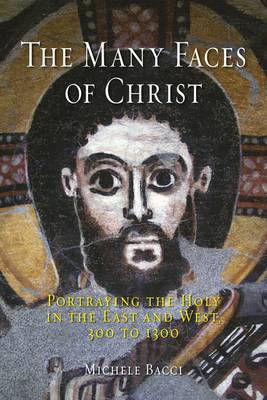
Door een staking bij bpost kan je online bestelling op dit moment iets langer onderweg zijn dan voorzien. Dringend iets nodig? Onze winkels ontvangen jou met open armen!
- Afhalen na 1 uur in een winkel met voorraad
- Gratis thuislevering in België vanaf € 30
- Ruim aanbod met 7 miljoen producten
Door een staking bij bpost kan je online bestelling op dit moment iets langer onderweg zijn dan voorzien. Dringend iets nodig? Onze winkels ontvangen jou met open armen!
- Afhalen na 1 uur in een winkel met voorraad
- Gratis thuislevering in België vanaf € 30
- Ruim aanbod met 7 miljoen producten
Zoeken
The Many Faces of Christ
Portraying the Holy in the East and West, 300 to 1300
Michele Bacci
Hardcover | Engels
€ 55,95
+ 111 punten
Omschrijving
Thanks to current portrayals of Jesus of Nazareth, we are apt to think of him as having long hair and a short beard. But, the holy scriptures do not describe Christ's physiognomy, and his representations are inconsistent in early Christian and medieval arts. How did this long-haired archetype come to be accepted in the late ninth century as the standard iconography of the Son of God? To answer this question, The Many Faces of Christ examines the complex historical and cultural dynamics underlying the making and final establishment of Christ's image between late antiquity and the early Renaissance. Taking into account a broad spectrum of iconographic and textual sources, Michele Bacci describes the process of creating Christ's image against the backdrop of ancient and biblical conceptions of beauty and physicality as indicators of moral, ascetic, or messianic qualities. He investigates the increasingly dominant role played by visual experience in Christian religious practice, which promoted belief in the existence of ancient documents depicting Christ's appearance, and he shows how this resulted in the shaping of portrait-like images that were said to be true to life. With glances at analogous progressions in the Jewish, Muslim, Buddhist, Hindu, Jain, and Taoist traditions, this beautifully illustrated book will be of interest to specialists of Late Antique, Byzantine, and medieval studies, as well as anyone interested in the shifting, controversial conceptions of the historical figure of Jesus Christ.
Specificaties
Betrokkenen
- Auteur(s):
- Uitgeverij:
Inhoud
- Aantal bladzijden:
- 256
- Taal:
- Engels
Eigenschappen
- Productcode (EAN):
- 9781780232683
- Verschijningsdatum:
- 15/08/2014
- Uitvoering:
- Hardcover
- Formaat:
- Genaaid
- Afmetingen:
- 165 mm x 236 mm
- Gewicht:
- 861 g

Alleen bij Standaard Boekhandel
+ 111 punten op je klantenkaart van Standaard Boekhandel
Beoordelingen
We publiceren alleen reviews die voldoen aan de voorwaarden voor reviews. Bekijk onze voorwaarden voor reviews.











